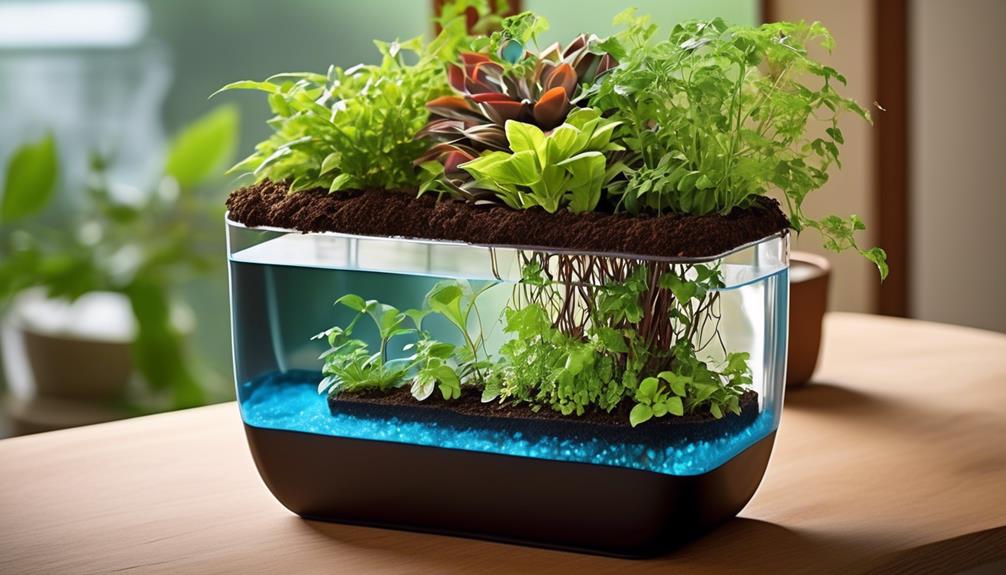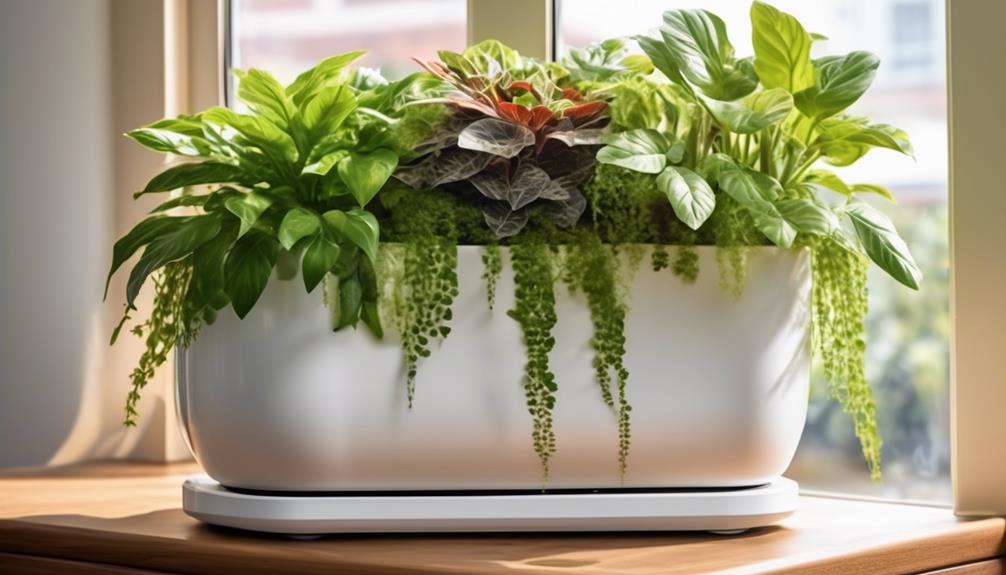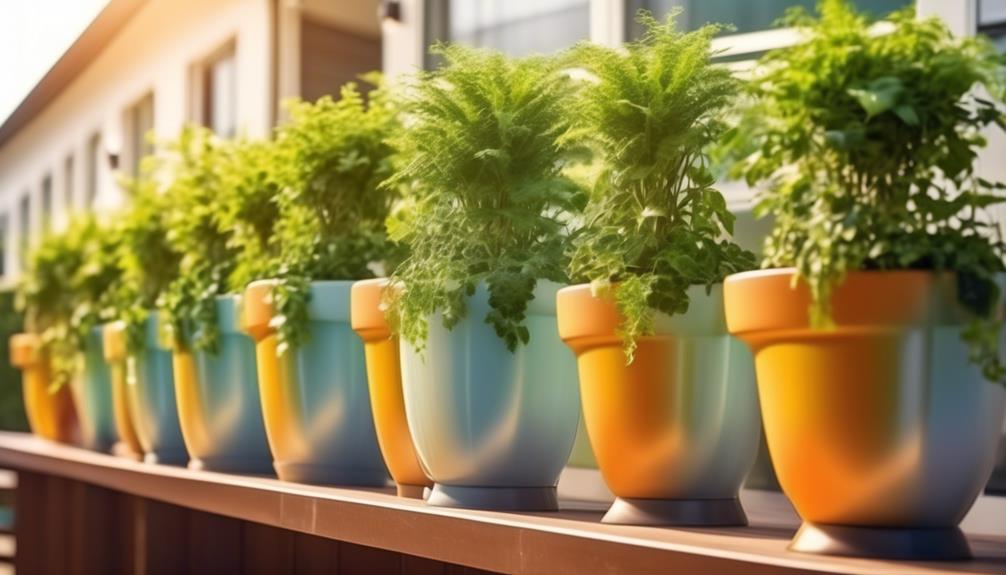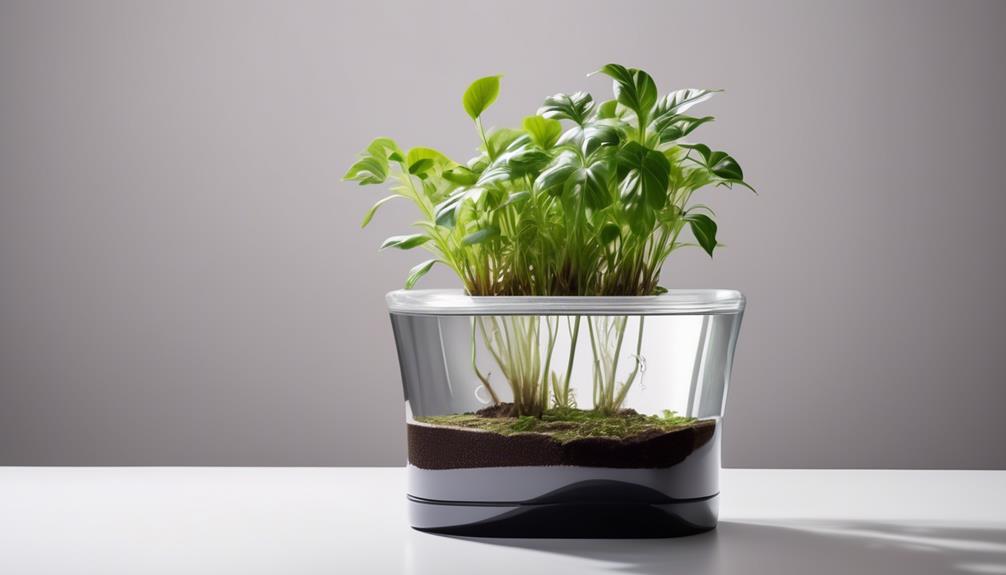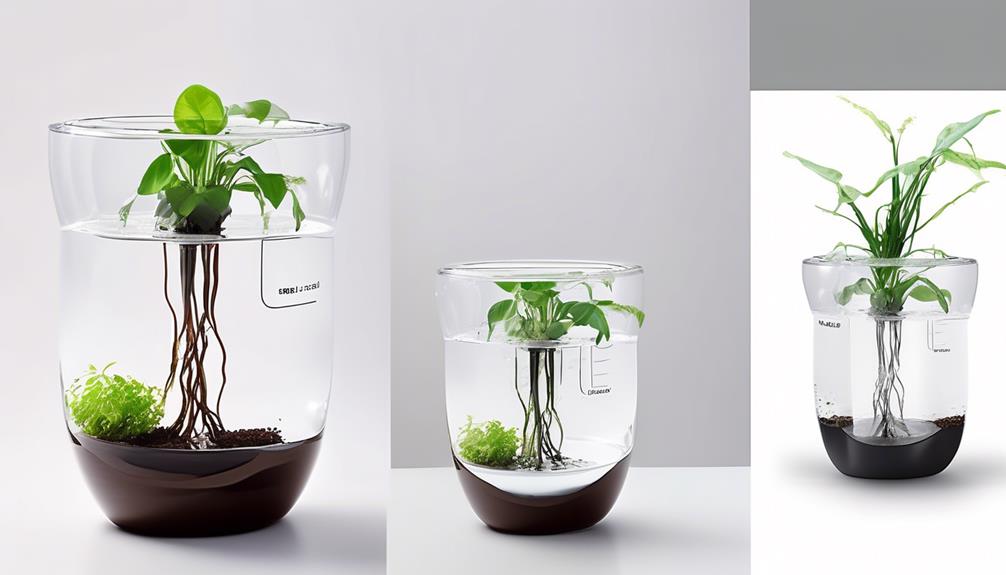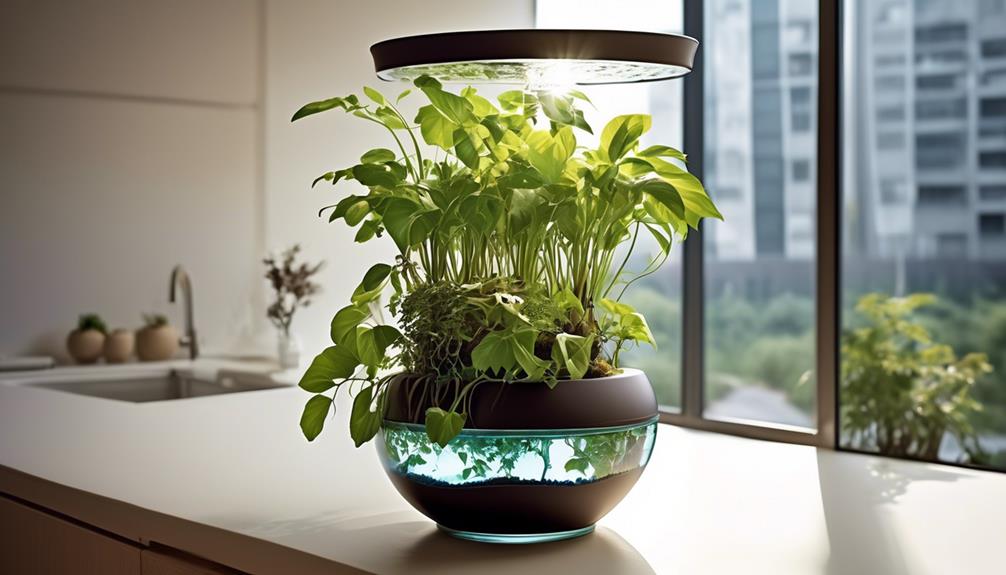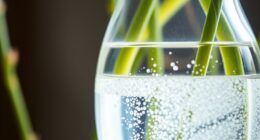In the field of horticulture, a self-watering planter is essential as it ensures your plants receive the perfect amount of water they need, saving you from the continual task of monitoring their watering requirements.
But what exactly does it mean? How does it work?
There's more to this innovative gardening solution than meets the eye, and understanding its inner workings can revolutionize the way we care for our plants.
Key Takeaways
- Self watering planters automatically provide water to plants, ensuring optimal moisture levels for healthy growth.
- The design includes a separate water reservoir and a water level indicator, preventing overwatering and underwatering.
- Self-watering planters use a capillary action mechanism to draw water from the reservoir into the soil and deliver it to the roots.
- Benefits of self watering planters include consistent water supply, minimized plant stress, water conservation, and reduced maintenance.
Definition of Self Watering Planter
Self watering planters are designed to automatically provide a consistent supply of water to plants, ensuring optimal moisture levels for healthy growth and reduced maintenance. The watering technology in these planters works through a system of wicking or capillary action, where the plant draws water from a reservoir as needed. This innovative design prevents overwatering, which can lead to root rot, and underwatering, which can cause wilting and stunted growth.
The planter design typically consists of a separate water reservoir at the bottom, ensuring that the plant roots have access to water without being submerged. This reservoir is often equipped with a water level indicator, allowing users to monitor the water supply easily.
The self watering mechanism is based on the principles of hydrology and soil science, providing plants with a consistent and balanced supply of water. By utilizing this technology, self watering planters promote healthier root development and efficient water usage. The design and functionality of these planters make them an ideal choice for individuals seeking to optimize plant care while minimizing the time and effort required for maintenance.
How Self Watering Planters Work
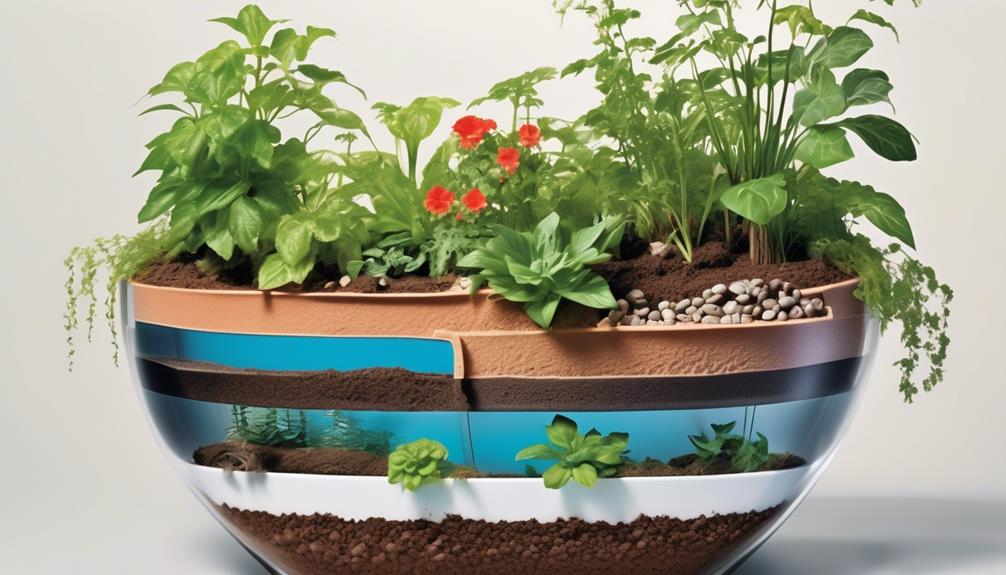
Self-watering planters operate through a capillary action mechanism that draws water from a reservoir into the soil, ensuring consistent moisture levels for the plant roots. This innovative design not only promotes healthier plant growth but also reduces the frequency of watering, offering convenience for busy individuals.
Watering Mechanism Explanation
Using a gravity-fed wicking system, self-watering planters provide a consistent and efficient method for delivering water to the plant's roots. The watering system design involves a reservoir at the bottom of the planter, which is separated from the soil by a water-permeable barrier. This barrier allows water to move upward through capillary action, ensuring that the soil remains consistently moist.
As the soil dries out, it creates a negative pressure that draws water from the reservoir into the soil. This process mimics natural plant hydration methods, where roots absorb water from the ground.
Additionally, some self-watering planters incorporate a water level indicator, allowing users to monitor the reservoir's water levels easily.
Benefits of Self-Watering
Harnessing the principles of capillary action, self-watering planters employ a gravity-fed wicking system to efficiently deliver water to the roots of plants, ensuring consistent soil moisture levels.
One of the primary benefits of self-watering planters is their ability to provide a consistent water supply to plants, reducing the risk of both under and over-watering. This controlled watering system minimizes the stress on plants, leading to healthier and more vigorous growth.
Additionally, self-watering planters can help conserve water by minimizing evaporation and runoff. Compared to traditional planters, self-watering systems offer the advantage of requiring less frequent watering, making them ideal for busy individuals or those with limited mobility.
However, some disadvantages include the initial cost and the need for occasional maintenance to ensure proper functioning.
Plant Care Convenience
Employing a gravity-fed wicking system based on capillary action, the self-watering planters ensure a consistent water supply to the roots of plants, thus promoting healthier growth and minimizing water wastage.
This method of automated watering provides plant care hacks, saving time and effort for gardening enthusiasts. The self-watering feature allows for a more consistent moisture level in the soil, reducing the need for frequent manual watering. This not only adds gardening convenience but also ensures that the plants receive the water they need, precisely when they need it.
By maintaining optimal moisture levels, these planters enable a more hands-off approach to plant care, making it easier for individuals with busy schedules to keep their plants thriving.
The automated watering system in self-watering planters is a game-changer for those seeking efficient and effective plant care solutions.
Components of Self Watering Planters
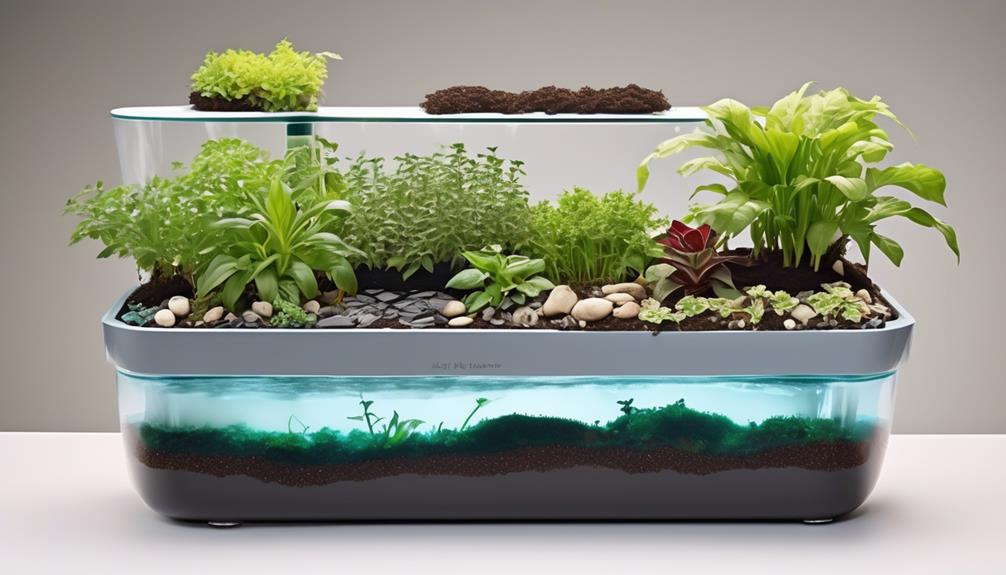
Efficient water distribution is a critical component of self watering planters, ensuring consistent moisture levels for plant growth. The components of a self watering planter are meticulously designed to facilitate optimal water management.
Here are the key components:
- Planter design
- The planter design of self watering planters incorporates a separate compartment at the bottom, known as the water reservoir. This reservoir is designed to store water separately from the soil and plant roots, preventing waterlogging and root rot.
- The planter design also includes a wicking mechanism, such as a wick or a capillary mat, which draws water from the reservoir into the soil as needed, ensuring a steady supply of moisture to the plant roots.
These components work in unison to create a self-sustaining watering system that provides plants with consistent moisture, promoting healthy growth and reducing the frequency of manual watering. Understanding the intricacies of these components allows for the efficient utilization of self watering planters to support thriving plant life.
Advantages of Self Watering Planters
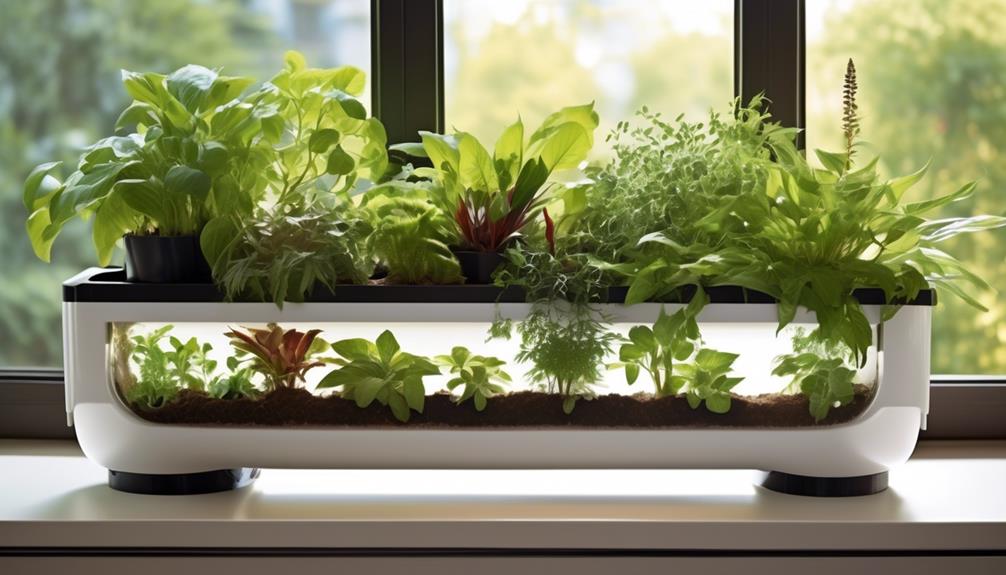
Self watering planters offer several key advantages for plant care. They provide efficient water usage by delivering just the right amount of water to the roots, preventing overwatering and underwatering.
This results in healthier, low maintenance plants that require less frequent attention and reduce the risk of plant stress.
Efficient Water Usage
While conserving water is essential for plant growth, self watering planters provide a practical solution for maintaining optimal soil moisture levels. Efficient gardening techniques are integral to sustainable plant care, and self watering planters play a key role in water conservation. Here's how they contribute to efficient water usage:
- Reduced Water Waste
- Self watering planters deliver water directly to the plant's roots, minimizing evaporation and runoff, which results in less water wastage.
- Precise Water Delivery
- These planters are designed to provide the right amount of water as needed, preventing overwatering or underwatering, thus optimizing water usage.
Low Maintenance Plants
As we consider the advantages of self watering planters for low maintenance plants, it becomes evident that these innovative systems play a crucial role in ensuring optimal soil moisture levels for plant growth.
When selecting plants for low maintenance, it's essential to choose varieties that are well-suited to the specific conditions provided by self watering planters. Drought-resistant plants like succulents and certain varieties of cacti are excellent choices as they require infrequent watering.
Additionally, plants with low to moderate water needs such as peace lilies, snake plants, and spider plants thrive in self watering planters, reducing the frequency of watering required.
Types of Self Watering Planters

Several different types of self watering planters are available on the market, each designed to provide a specific method for delivering water to plants.
- Different Materials and Decorative Options:
- Plastic: Lightweight and affordable, suitable for indoor and outdoor use. Some models mimic the appearance of ceramic or stone.
- Ceramic and Terracotta: Durable and aesthetically pleasing, ideal for indoor settings. However, they may be prone to cracking if exposed to freezing temperatures.
- Size Options and Plant Compatibility:
- Small Planters: Suitable for individual plants or small herb gardens. They're ideal for compact spaces such as windowsills or countertops.
- Large Planters: Designed for bigger plants or multiple plant arrangements. These are suitable for spacious indoor areas or outdoor settings.
When selecting a self watering planter, consider the material's durability and the planter's decorative appeal. Additionally, ensure that the planter size corresponds with the plants' root system and growth potential. By matching the planter to the plant's needs, you can create an optimal environment for healthy and thriving greenery.
Choosing the Right Self Watering Planter
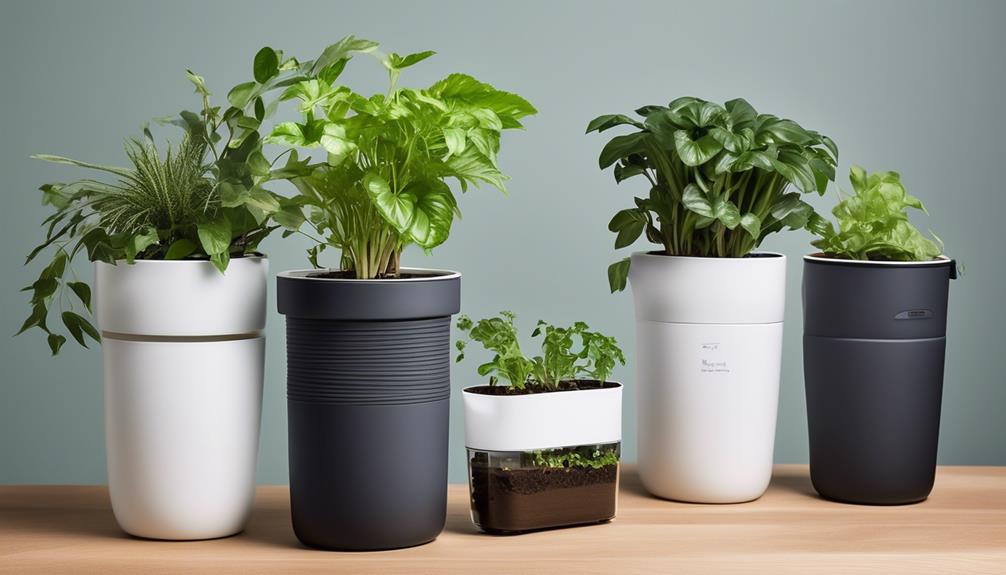
When selecting a self watering planter, it's crucial to consider the available size options, as the planter must be suited to the specific plant's root system.
The watering system mechanism should be carefully assessed, ensuring it provides consistent and reliable moisture distribution.
Additionally, the material durability is a key factor to evaluate, as it directly impacts the planter's longevity and ability to withstand environmental conditions.
Planter Size Options
One important factor to consider when choosing the right self-watering planter is the size, which directly impacts the plant's growth and water needs.
- Planter Drainage:
- Adequate planter size ensures proper drainage, preventing waterlogged soil and root rot.
- Insufficient size can lead to poor drainage, affecting soil moisture levels and root health.
Selecting the appropriate planter size is crucial for maintaining optimal soil moisture and supporting plant growth. It directly influences the planter's drainage capabilities, preventing waterlogging and ensuring adequate aeration for healthy root development.
Inadequate sizing can compromise the planter's ability to manage soil moisture, impacting the overall health and vitality of the plant. Therefore, understanding the relationship between planter size, drainage, and soil moisture is essential for effectively choosing the right self-watering planter.
Watering System Mechanism
To ensure efficient selection of the appropriate self-watering planter, it is important to understand the intricate mechanisms of the watering system and their impact on plant health and growth. When choosing a self-watering planter, it's crucial to consider the watering frequency and soil moisture levels to support optimal plant growth. The watering system mechanism plays a vital role in maintaining the right balance of moisture for the plants. Here's a table summarizing the key aspects of the watering system mechanism:
| Mechanism | Description | Impact on Plant Health |
|---|---|---|
| Water Reservoir | Stores excess water for gradual release | Consistent moisture supply |
| Wick or Capillary System | Draws water from reservoir to soil | Uniform soil moisture distribution |
| Water Level Indicator | Monitors water level for timely refilling | Prevents over or under-watering |
Understanding these mechanisms will aid in choosing the most suitable self-watering planter for your plants.
Material Durability
In assessing the material durability of self-watering planters, our focus lies on identifying robust construction materials that ensure long-term functionality and structural integrity for sustained plant care. When considering material selection for self-watering planters, it's vital to prioritize durability and weather resistance. This ensures the planter can withstand outdoor elements and maintain its functionality over time.
The planter design should incorporate materials known for their longevity, such as UV-stabilized polypropylene or high-quality resin, to prevent cracking, fading, or deterioration due to environmental exposure. Additionally, the planter's internal components, such as the water reservoir and wicking system, should be made from durable, non-corrosive materials to guarantee long-lasting performance and minimal maintenance requirements.
Setting Up Self Watering Planters

We can achieve optimal performance from self watering planters by carefully following the setup instructions provided by the manufacturer.
Setting up self watering planters involves understanding the self watering technology and configuring the planter for indoor vs outdoor use.
When setting up a self watering planter, it's crucial to ensure that the watering system is correctly assembled and functioning. This includes checking the water reservoir, wicking system, and overflow mechanisms.
For indoor use, it's important to consider factors such as the type of soil and the specific watering needs of the plants.
Outdoor self watering planters may require additional considerations, such as protection from extreme weather conditions and adequate drainage.
Proper setup also involves calibrating the watering system to meet the specific needs of the plants being grown.
Understanding the setup process for self watering planters is essential for maintaining healthy and thriving plants while minimizing the effort required for watering and maintenance.
Maintenance of Self Watering Planters
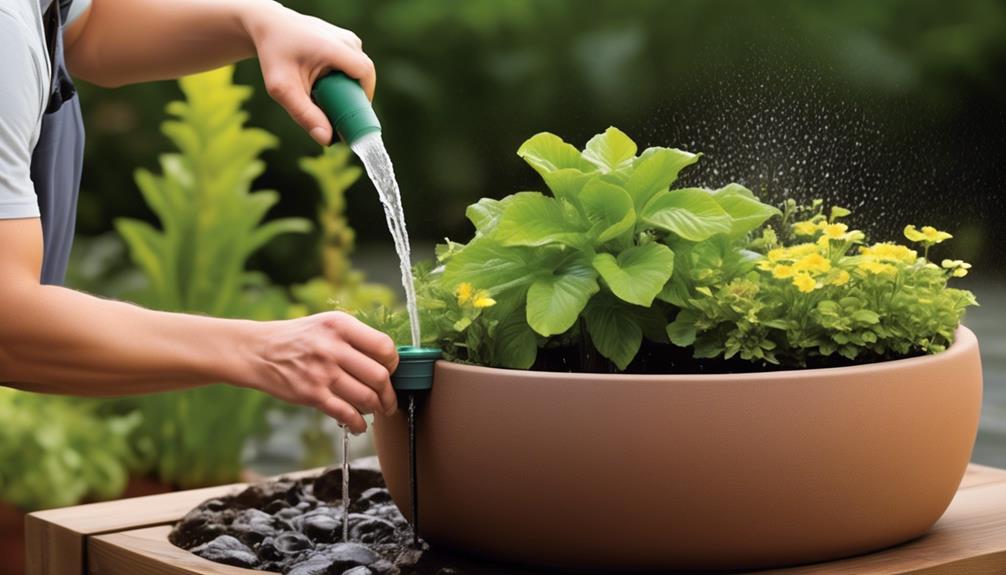
Understanding the setup process for self watering planters is essential for effectively maintaining their functionality and ensuring the health of the plants they support. When it comes to the maintenance of self watering planters, it's crucial to focus on two key aspects: watering frequency and soil moisture levels.
- Watering Frequency
- Regularly check the water reservoir to ensure an adequate supply of water for the plants.
- Adjust the watering frequency based on the specific needs of the plant and the environmental conditions. Factors such as temperature and humidity can influence the rate of water consumption by the plants.
- Soil Moisture Levels
- Monitor the soil moisture regularly to prevent overwatering or underwatering. This can be done by using a soil moisture meter or simply by feeling the soil with your fingers.
- Adjust the wick or watering mechanism based on the soil moisture levels to maintain optimal moisture for the plants.
Best Plants for Self Watering Planters
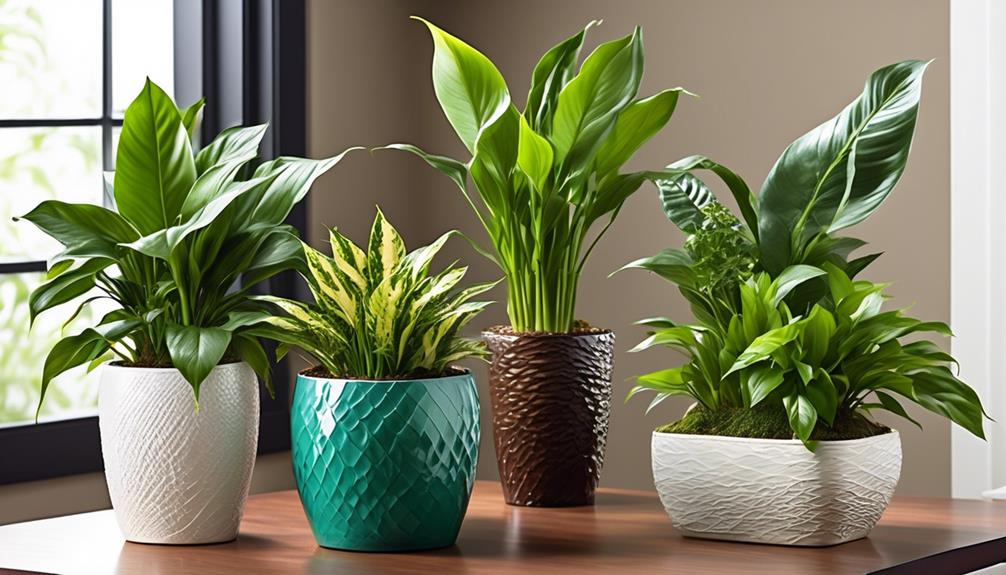
When selecting plants for self watering planters, it is important to consider their specific water and nutrient needs to ensure optimal growth and health. The table below outlines ideal plant choices for self watering planters and their respective watering frequencies.
| Ideal Plant Choices | Watering Frequency | Light Requirements |
|---|---|---|
| Spider Plant | Once a week | Indirect sunlight |
| Peace Lily | Once a week | Low to medium light |
| English Ivy | Once a week | Low to medium light |
| Snake Plant | Every 2-6 weeks | Low to bright light |
| Philodendron | Once a week | Medium to bright light |
These plant choices are well-suited for self watering planters due to their moderate water requirements and adaptability to different light conditions. Spider plants, peace lilies, and English ivies thrive with weekly watering, making them excellent options for self watering planters. Snake plants and philodendrons, on the other hand, require less frequent watering, which aligns with the self watering system's design. By selecting plants that match the watering needs of self watering planters, you can ensure the long-term health and vitality of your indoor greenery.
Self Watering Planters for Indoor Use

Self watering planters for indoor use provide a convenient and efficient method for maintaining optimal moisture levels in potted plants. These planters are designed to support indoor gardening by ensuring consistent plant hydration.
- Water Reservoir: Self watering planters feature a built-in water reservoir that holds excess water. This reservoir allows the plant to draw water as needed, promoting consistent hydration and preventing overwatering.
- Capillary Action: Many self watering planters utilize capillary action, where a wick or porous material draws water from the reservoir into the soil. This process mimics natural hydration patterns, ensuring the plant receives water as required.
- Optimal Conditions: Indoor environments often have controlled temperatures and lighting, making it essential to maintain optimal moisture levels. Self watering planters offer a reliable solution for indoor gardening, providing a consistent water supply to support plant growth and health.
Self Watering Planters for Outdoor Use

Utilizing advanced irrigation technology, outdoor self-watering planters facilitate efficient and controlled hydration for plants in external environments. These outdoor planters are equipped with a self-watering system that automatically delivers water to the plants based on their specific needs. The system typically consists of a water reservoir, a wicking mechanism, and a water level indicator.
The reservoir stores the water, which is drawn up by the wick and delivered to the plant's roots as required. The water level indicator allows the user to monitor the water level, ensuring that the plants receive an adequate water supply.
Outdoor self-watering planters are designed to withstand various weather conditions, making them ideal for use in gardens, patios, or balconies. The efficient watering system helps to prevent overwatering or underwatering, promoting healthier plant growth. Additionally, these planters reduce the frequency of manual watering, saving time and effort for the gardener.
The design of outdoor self-watering planters is engineered to provide optimal growing conditions for plants in outdoor settings, making them a valuable tool for gardening enthusiasts seeking to maintain thriving and vibrant plant life.
DIY Self Watering Planters
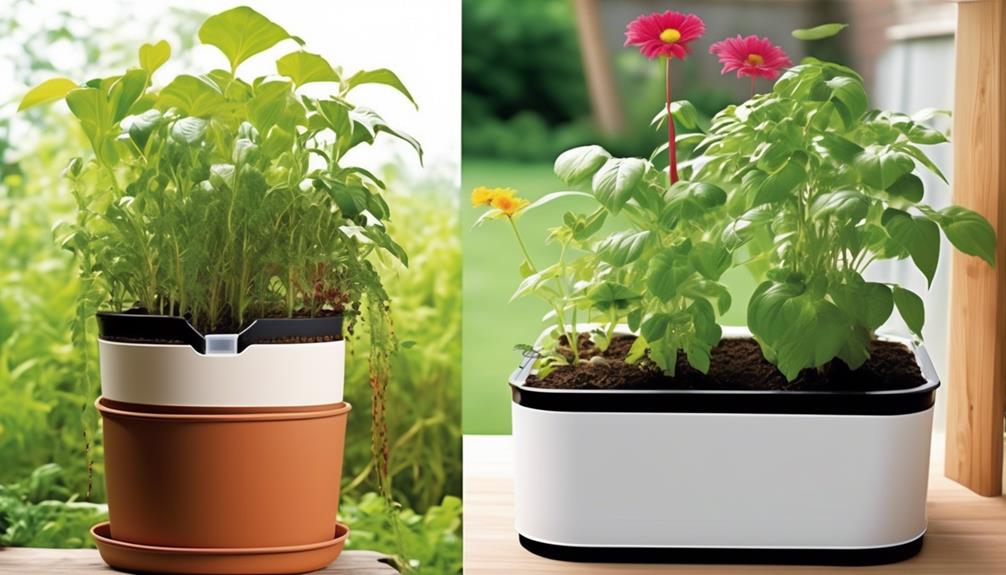
Developing DIY self-watering planters requires precise measurement and strategic placement of the water reservoir to ensure consistent hydration for the plants.
To achieve successful DIY irrigation solutions, we must consider the following:
- Water Reservoir Capacity: Calculating the appropriate size of the water reservoir is crucial. Factors such as plant type, container size, and environmental conditions must be taken into account to determine the ideal reservoir capacity.
- Capillary Action: Understanding the capillary action of the growing medium is essential. By strategically placing the watering wick, we can ensure that water is effectively drawn up to the plant's roots, maintaining optimal hydration levels.
Troubleshooting Self Watering Planters
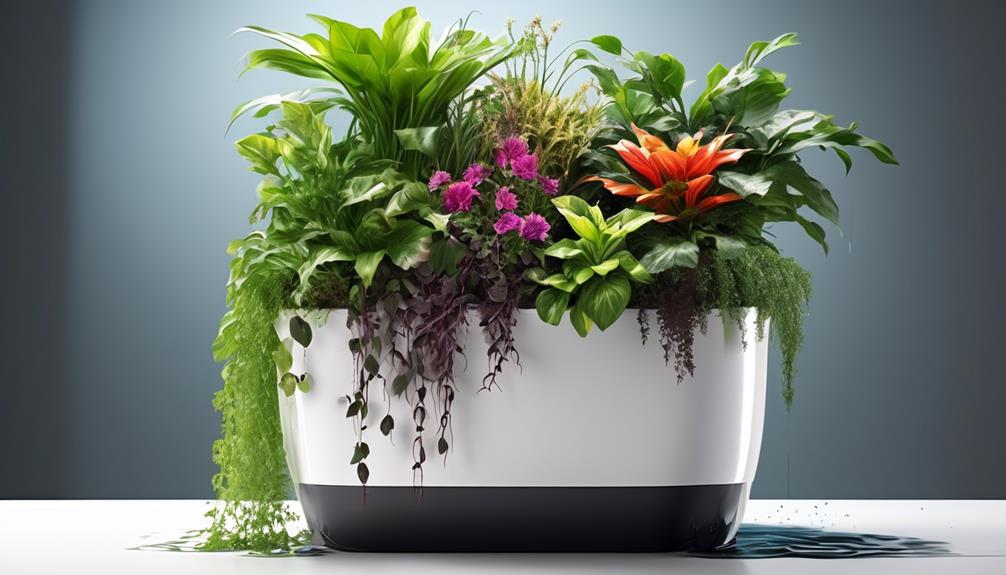
After conducting extensive research and experimentation, we have identified common issues that can arise in self watering planters and have developed effective troubleshooting methods to address them. One of the most prevalent issues with self watering planters is overwatering, which can lead to root rot and adversely affect plant health. To troubleshoot overwatering problems, it's crucial to ensure proper drainage and monitor the water level regularly. Additionally, preventing root rot in self watering planters is essential for maintaining plant vitality. This can be achieved by using a well-draining potting mix, allowing the soil to partially dry out between watering cycles, and ensuring adequate airflow around the roots.
| Issue | Troubleshooting Method |
|---|---|
| Overwatering | 1. Check drainage holes for blockages. <br> 2. Use a moisture meter to monitor soil moisture. <br> 3. Adjust watering frequency based on plant needs. |
| Root Rot | 1. Use a well-draining potting mix. <br> 2. Allow soil to partially dry between watering. <br> 3. Ensure proper airflow around the roots. |
Frequently Asked Questions
Can Self Watering Planters Be Used for All Types of Plants, Including Succulents and Cacti?
Yes, self-watering planters can be used for all types of plants, including succulents and cacti.
Succulents require less watering, so it's important to monitor the moisture levels in the planter.
The self-watering system can provide a consistent level of moisture, promoting healthy plant growth.
Cacti, on the other hand, are adapted to survive in arid conditions and may require even less frequent watering in a self-watering planter.
Are Self Watering Planters Suitable for People Who Travel Frequently and May Not Be Able to Water Their Plants Regularly?
Self watering planters offer numerous benefits for frequent travelers. They provide a consistent water supply, reducing the need for regular maintenance. Installation is straightforward, and there are alternatives available to suit different plant types.
These planters are ideal for individuals who can't water their plants regularly, ensuring proper hydration for the flora. This reduces the stress of plant care during travel and promotes healthy growth.
Can Self Watering Planters Be Used in Extreme Weather Conditions, Such as High Temperatures or Freezing Temperatures?
In extreme temperatures, self-watering planters can be a valuable asset for maintaining plant survival. These planters regulate water intake to provide consistent hydration, crucial for plant care in harsh conditions.
Their design ensures travel-friendly and low-maintenance plant care, making them suitable for those who may not be able to tend to their plants regularly.
The self-regulating nature of these planters supports plant health and growth, even in the face of extreme weather conditions.
What Are the Potential Drawbacks or Limitations of Using Self Watering Planters?
When using self-watering planters, potential maintenance and watering frequency are crucial factors to consider.
Drawbacks may include the need for regular cleaning to prevent mold or algae growth in the water reservoir.
Additionally, the soil may become waterlogged if the watering system malfunctions, leading to root rot and nutrient deficiencies.
Understanding the limitations of self-watering planters is essential for successful and healthy plant growth.
Are There Any Special Considerations for Using Self Watering Planters in Different Climates or Regions?
In desert climates, using self watering planters requires careful consideration of water evaporation rates and soil moisture retention.
In rainy regions, proper drainage and overflow management are crucial to prevent waterlogging.
Our research indicates that these factors significantly impact plant health.
By adjusting watering frequency and monitoring soil moisture levels, we can optimize plant growth in various climates.
These findings emphasize the importance of tailoring self watering planter usage to specific environmental conditions for optimal results.
Can you explain the concept of a self-watering planter?
A self-watering planter is a unique gardening tool designed to provide plants with a consistent water source without the need for manual intervention. The self watering planter definition entails a system that includes a water reservoir, wicking mechanism, and soil chamber. The reservoir is filled with water, while the wicking mechanism draws moisture up into the soil, ensuring plants receive adequate hydration. This concept enables easier plant care and maintenance, especially for those who may forget to water regularly.
Conclusion
In conclusion, self watering planters are a convenient and efficient way to ensure your plants receive the right amount of water without constant monitoring.
With their innovative design and reliable components, these planters offer a hassle-free solution for both indoor and outdoor gardening.
By incorporating self watering planters into your gardening routine, you can enjoy healthy, thriving plants while saving time and effort.
It's like having a personal plant caretaker that never misses a watering session.

